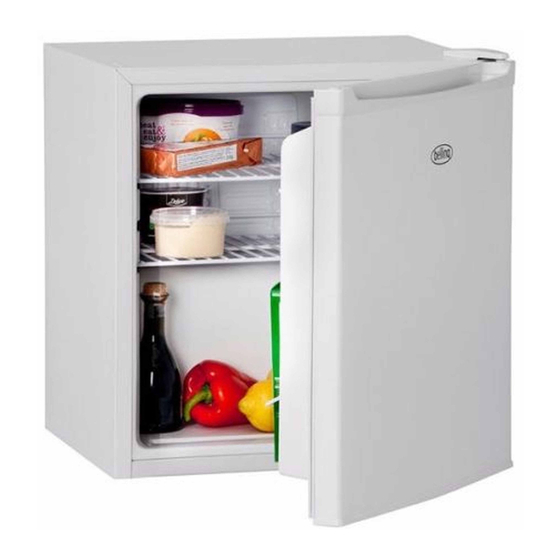
Table of Contents
Advertisement
Quick Links
Advertisement
Table of Contents

Summary of Contents for Belling BL45WH
- Page 1 Refrigerator USER’S MANUAL BL45WH...
-
Page 2: Table Of Contents
Contents Safety Instruc ons ………………………………………. Electrical Safety ………………………………………. Transpo on & Handling ………………………………………. Installing & Switch on your Appliance ………………………………………. Before Switching On ………………………………………. Product Overview ………………………………………. Unit & Spare Parts ………………………………………. Usage ………………………………………. Temperature Selec on ………………………………………. Door Reversal ………………………………………. -
Page 3: Safety Instruc Ons
Safety Instructions Important note: Please read this booklet before installing and switching on this appliance. The manufacturer assumes no responsibility for incorrect installation and usage as described in this booklet. • This model uses natural refrigerant gas as part of its cooling system. This gas is known as R600a (Isobutene) and is environmentally friendly but can be combustible. -
Page 4: Electrical Safety
• This appliance can be used by children aged from 8 years and above and persons with reduced physical, sensory or mental capabilities or lack of experience and knowledge if they have been given supervision or instruction concerning use of the appliance in a safe way and understand the hazards involved. -
Page 5: Transpo On & Handling
Transportation and Handling For safe lifting, tilt the appliance backwards by no more than 45 degrees, hold the base and rear corners of cabinet. Lift the refrigerator carefully. Never use the door handles for lifting. To move the refrigerator on a flat level surface, tilt it slightly backwards and push backwards. -
Page 6: Before Switching On
• This appliance should only be placed on a flat, firm surface. • Choose a dry and well-ventilated space. • The appliance should be positioned so that the plug is easily accessible. Before Switching On • Before using your appliance, add a teaspoon of bicarbonate of soda to warm water and with a damp cloth wipe down all parts of the new appliance, then repeat the process with a clean damp cloth and dry. -
Page 7: Product Overview
Product Overview 1. Ice-cube compartment 6. Lower hinge 2. Thermostat 7. Drip tray 3. Upper hinge 8. Shelf 4. Handle recess 9. Adjustable foot 5. Door shelves Unit Parts & Spare Parts Before installation, check that all parts detailed in the product overview are present. -
Page 8: Usage
Usage Allow to stand for a minimum of 3 hours before plugging in to the mains The temperature in the appliance is controlled by the temperature control knob located inside the fridge. Rotate the control knob left or right to regulate the temperature inside the fridge. -
Page 9: Door Reversal
Door Reversal You will need to tilt the fridge backward to access the lower hinge which holds screws. Do not tilt more than 45 degrees and do not lay the fridge flat on its side. Reversing the door: 1. Remove the top plastic hinge cover and set aside 2. - Page 10 Door Reversal 4. Remove the adjustable foot at the bottom of the fridge and set aside. 5. Unscrew the two screws holding the bottom door hinge and carefully moving it across to the opposite side and fix into position. Care must be taken as the door will be loose.
-
Page 11: Energy Saving Advice
Energy Saving Advice • Do not install the appliance close to sources of heat, such as a cooker, dishwasher or radiator. • Locate the appliance in a cool well-ventilated room and make sure that the air vents are clear. • Try to avoid keeping the doors open for a long time, warm air will enter the cabinet and may cause a build-up of ice as well as affecting the energy consumption. -
Page 12: Maintenance & Cleaning
Maintenance & Cleaning Disconnect the appliance from the power supply before cleaning. Internal Cleaning • Do not pour water over the appliance. • The cavity should be cleaned periodically using a solution of bicarbonate of soda and lukewarm water (5ml to 0.5 litre of water) •... -
Page 13: Trouble Shoo Ng
Trouble shooting Problem Solution Check that the appliance is switched on. Check that there has not been a power cut. Check that the plug is not faulty. Check that the fuse has not blown. The fridge doesn't work Check that the voltage is correct for the appliance. Are there any faults with the socket? For this purpose, try the plug of your appliance by connecting it to a socket which you are sure is working. - Page 14 Trouble shooting Problem Solution Check all the food and drink that is in the fridge is in date and correctly packaged. If it isn’t then it should be removed immediately or repackaged. Smell/odour Check for spillages on each shelf, rack and drawer. You may need to remove the drawers to check that no spillages have settle underneath them.









Need help?
Do you have a question about the BL45WH and is the answer not in the manual?
Questions and answers